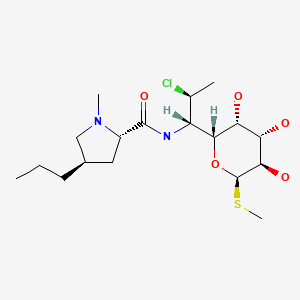Attribution Statement: LactMed is a registered trademark of the U.S. Department of Health and Human Services.
NCBI Bookshelf. A service of the National Library of Medicine, National Institutes of Health.
Drugs and Lactation Database (LactMed®) [Internet]. Bethesda (MD): National Institute of Child Health and Human Development; 2006-.
CASRN: 18323-44-9

Drug Levels and Effects
Summary of Use during Lactation
Clindamycin has the potential to cause adverse effects on the breastfed infant's gastrointestinal flora. If oral or intravenous clindamycin is required by a nursing mother, it is not a reason to discontinue breastfeeding, but an alternate drug may be preferred. Monitor the infant for possible effects on the gastrointestinal flora, such as diarrhea, candidiasis (thrush, diaper rash) or rarely, blood in the stool indicating possible antibiotic-associated colitis.
Vaginal application is unlikely to cause infant side effects, although about 30% of a vaginal dose is absorbed. Infant side effects are unlikely with topical administration for acne; however, topical application to the breast may increase the risk of diarrhea if it is ingested by the infant. Only water-miscible cream, foam, gel or liquid products should be applied to the breast because ointments may expose the infant to high levels of mineral paraffins via licking.[1]
Drug Levels
Maternal Levels. Two women were given clindamycin 150 mg orally. Breastmilk levels of clindamycin averaged 1.3 mg/L 4 hours after the dose.[2]
Two women were treated with clindamycin 600 mg intravenously every 6 hours followed by 300 mg orally every 6 hours (time postpartum not stated). Peak milk levels after the intravenous dose were 2.65 mg/L at 3.5 hours after the dose in one and 3.1 mg/L at 30 minutes after the dose in the other. During the oral regimen, peak milk levels were 1.3 mg/L at 3.5 hours after the dose in the first woman and 1.8 mg/L at 2 hours after the dose in the other.[3]
Five women were given oral clindamycin 150 mg three times daily during the first 2 weeks postpartum. Milk levels were measured after at least 1 week of therapy and averaged 1.2 mg/L (range <0.5 mg/L to 3.1 mg/L) 6 hours after the dose.[4]
After a single oral dose of 150 mg of clindamycin in 2 women, milk levels averaged from 0.3 to 1.2 mg/L between 1 and 6 hours after the dose. The peak occurred at 2 hours after the dose in one woman and 4 hours after the dose in the other.[5]
After a single dose of 600 mg of clindamycin intravenously to 15 women who were 1 month postpartum, milk clindamycin levels averaged 1.03 mg/L 2 hours after the dose.[6]
Infant Levels. Relevant published information was not found as of the revision date.
Effects in Breastfed Infants
Bloody stools in a 5-day-old breastfed infant were possibly caused by concurrent maternal clindamycin 600 mg intravenously every 6 hours and gentamicin 80 mg intravenously every 8 hours. The infant's stools were reported to have normal flora and the stools became guaiac negative 24 hours after discontinuation of breastfeeding. On day 6 of age, the infant resumed breastfeeding after discontinuation of maternal antibiotics with no further difficulties.[7]
Effects on Lactation and Breastmilk
Relevant published information was not found as of the revision date.
Alternate Drugs to Consider
(Systemic infections) Amoxicillin and Clavulanic Acid, Doxycycline, Erythromycin; (Methicillin-resistant Staph. aureus) Doxycycline, Minocycline, Trimethoprim-Sulfamethoxazole, Vancomycin; (Bacterial Vaginosis) Metronidazole; (Topical for Acne) Azelaic Acid, Benzoyl Peroxide, Erythromycin, Tretinoin; (Topical for Skin infections) Bacitracin, Mupirocin
References
- 1.
- Noti A, Grob K, Biedermann M, et al. Exposure of babies to C(15)-C(45) mineral paraffins from human milk and breast salves. Regul Toxicol Pharmacol. 2003;38:317–25. [PubMed: 14623482]
- 2.
- Matsuda S, Mori S, Azuma S. Clinical evaluation of clindamycin in gyneco-obstetrics. Chemotherapy (Tokyo). 1969;17:899–900.
- 3.
- Smith JA, Morgan JR, Rachlis AR, et al. Clindamycin in human breast milk. Can Med Assoc J 1975;112:806. Letter. PMID: 20312646. [PMC free article: PMC1958966] [PubMed: 20312646]
- 4.
- Stéen B, Rane A. Clindamycin passage into human milk. Br J Clin Pharmacol. 1982;13:661–4. [PMC free article: PMC1402074] [PubMed: 7082533]
- 5.
- Matsuda S. Transfer of antibiotics into maternal milk. Biol Res Pregnancy Perinatol. 1984;5:57–60. [PubMed: 6743732]
- 6.
- Zhang Y, Zhang Q, Xu Z. Zhonghua Fu Chan Ke Za Zhi. 1997;32:288–92. [Tissue and body fluid distribution of antibacterial agents in pregnant and lactating women] [PubMed: 9596854]
- 7.
- Mann CF. Clindamycin and breast-feeding. Pediatrics 1980;66:1030-1. Letter. PMID: 7454470. [PubMed: 7454470]
Substance Identification
Substance Name
Clindamycin
CAS Registry Number
18323-44-9
Disclaimer: Information presented in this database is not meant as a substitute for professional judgment. You should consult your healthcare provider for breastfeeding advice related to your particular situation. The U.S. government does not warrant or assume any liability or responsibility for the accuracy or completeness of the information on this Site.
- User and Medical Advice Disclaimer
- Drugs and Lactation Database (LactMed) - Record Format
- LactMed - Database Creation and Peer Review Process
- Fact Sheet. Drugs and Lactation Database (LactMed)
- Drugs and Lactation Database (LactMed) - Glossary
- LactMed Selected References
- Drugs and Lactation Database (LactMed) - About Dietary Supplements
- Breastfeeding Links
- PMCPubMed Central citations
- PubChem SubstanceRelated PubChem Substances
- PubMedLinks to PubMed
- Review Erythromycin.[Drugs and Lactation Database (...]Review Erythromycin.. Drugs and Lactation Database (LactMed®). 2006
- Review Neomycin.[Drugs and Lactation Database (...]Review Neomycin.. Drugs and Lactation Database (LactMed®). 2006
- Review Tobramycin.[Drugs and Lactation Database (...]Review Tobramycin.. Drugs and Lactation Database (LactMed®). 2006
- Review Prilocaine.[Drugs and Lactation Database (...]Review Prilocaine.. Drugs and Lactation Database (LactMed®). 2006
- Review Clobetasol.[Drugs and Lactation Database (...]Review Clobetasol.. Drugs and Lactation Database (LactMed®). 2006
- Clindamycin - Drugs and Lactation Database (LactMed®)Clindamycin - Drugs and Lactation Database (LactMed®)
Your browsing activity is empty.
Activity recording is turned off.
See more...
